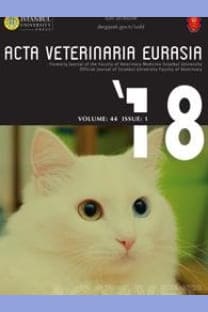Histomorphological Examination of Skin Wound Healing Under the Effect of Avocado Oil in Wistar Rats
___
Balbino, C. A., Pereira, L. M., & Curi, R. (2005). Mechanisms involved in wound healing: A revision. Brazilian Journal of Pharmaceutical Sciences, 41, 27–51. [CrossRef]Bruce, A., & Schaffer, B. (2012). The avocado: Botany, production and uses (2nd ed, pp. 45–501). Wolstenholme, Boston, USA: Antony William Whiley.
Camila, A., Eryvelton, F., Rafaella, B., & Daniele, C. (2013). Effect of semisolid formulation of Persea Americana Mill (Avocado) oil onwound healing in rats. Evidence-Based Complementary and Alternative Medicine, 2013, 1–8.
Deodhar, A. K., & Rana, R. E. (1997). Surgical physiology of wound healing: A review. Journal of Postgraduate Medicine, 43(2), 52–56. [CrossRef])
Falzon, C. C., & Balabanova, A. (2017). Phytotherapy: An introduction to herbal medicine. Primary Care, 44(2), 217–227. [CrossRef]
Flores, M. A., Perez-Camino, M. C., & Troca, J. (2014). Preliminary studies on composition, quality and oxidative stability of commercial avocado oil produced in Chile. Journal of Food Science and Engineering, 4, 21–26.
Fulgoni, V. L., Dreher, M., & Davenport, A. J. (2013). Avocado consumption is associated with better diet quality and nutrient intake, and lower metabolic syndrome risk in US adult: Results from the national health and nutrition examination survey, 2001–2008. Nutrition Journal, 12, 1. [CrossRef]
Ghasemi, A., & Ketabi, M. (2018). Antimicrobial activity of Avocado leaf extract in subject with poor oral hygiene: An invitro study. Journal Infohan Dental School, 14, 410–418.
Groeber, F., Holeiter, M., & Hampel, M. (2011). Skin tissue engineering— in vivo and vitro applications. Advanced Drug Delivery Reviews, 128, 352–366.
Hatz, R. A., Niedner, R., Vanscheidt, W., & Westerhof, W. (1994). Wound healing and wound management (4th ed, pp. 1–68). Berlin, Germany: Springer-Verlag.
Jain, U., & Gupta, N. (2010). Prominent wound healing properties of indigenous medicines. Journal of Natural Pharmaceuticals, 1(1), 2–13. [CrossRef]
Kawagishi, H., Fukumoto, Y., Hatakeyama, M., He, P., Arimoto, H., Matsuzawa, T., Arimoto, Y., Suganuma, H., Inakuma, T., & Sugiyama, K. (2001). Liver injury suppressing compounds from avocado (Persea americana). Journal of Agricultural and Food Chemistry, 49(5), 2215–2221. [CrossRef]
Larijani, L., Ghasemi, M., Abedian Kenari, S., Naghshvar, F., Azadbakht, M., & Yazdani Cherati, J. (2012). Investigating the effects of 4 types of avocado fruit extract on squamous cell carcinoma of the mouth and esophagus in comparison with peripheral blood mononuclear cells and control group. Journal of Mazandaran University of Medical Sciences, 22, 48–54.
Martin, P. (1997). Wound healing-aiming for perfect skin regeneration. Science, 276(5309), 75–81. [CrossRef]
Massafera, G., Costa, T. B., & Oliveira, J. D. (2010). Fatty acids of mesocarp and seed oils of avocados (Persea Americana Mill) from Ribeirão Preto, SP. Alimentos e Nutriçã, 21, 325–331.
Nayak, B. S., Raju, S. S., & Chalapathi Rao, A. V. (2008). Wound healing activity of Persea Americana (avocado) fruit: A preclinical study on rats. Journal of Wound Care, 17(3), 123–126. [CrossRef]
McDaniel, J. C., Belury, M., Ahijevych, K., & Blakely, W. (2008). Omega-3 fatty acids effect on wound healing. Wound Repair and Regeneration, 16(3), 337–345. [CrossRef]
Salgado, J. M., Danieli, F., Regitano-D’Arce, M. A. B., Frias, A., & Mansi, D. N. (2008). The avocado oil (Persea Americana Mill) as a raw material for the food industry. Ciência e Tecnologia de Alimentos, 28, 20–26. [CrossRef]
Stücker, M., Memmel, U., Hoffmann, M., Hartung, J., & Altmeyer, P. (2001). Vitamin B12 cream containing avocado oil in the therapy of plaque psoriasis. Dermatology, 203(2), 141–147. [CrossRef]
Vega, R. G., Rivero, R. R., & Moreiro, R. G. (2000). Study of avocado action on the process healing in burnt rats, 4 (pp. 39–43). Archivo Médico Camaguey.
Viviane, C., Indiara, B., Mariana, P., & Henrique, F. (2018). Persea Americana Mill. Crude extract exhibits antinociceptive effect on UVB radiation-induced skin injury in mice. Inflammopharmacology, 27, 323–338.
- ISSN: 2618-639X
- Yayın Aralığı: 3
- Başlangıç: 1975
- Yayıncı: İstanbul Üniversitesi-Cerrahpaşa
İSMAİL ÇETİN, Deniz BELENLI, Derya YEŞİLBAĞ, Firdevs KORKMAZ TURGUD, Doğan NARİNÇ
16S Bacterial Metagenomic Analysis of Herby Cheese (Otlu Peynir) Microbiota
Mert SUDAĞIDAN, Mediha Nur Zafer YURT, Behiye Büşra TAŞBAŞI, Elif Esma ACAR, Esra ERSOY ÖMEROĞLU, Samet UÇAK, VELİ CENGİZ ÖZALP, Ali AYDIN
Nadiah Jafar ALI, Sabri Mohd YUSOFF, Polycarp Nwunuji TANKO, Nadirah Abu NOR, Opeyemi Onilude MAYOWA
Alla YEMELYANENKO, Mykola CHORNOZUB, Nataliia KOZII, Olexander EMELIANENKO, Liydmula STOVBETSKA, Oksana POROSHINSKA, Volodymyr SHAHANENKO, Vasyl KOZIY
Hamza Doğan ÖZİVGEN, Yalçın AKBULUT
Gizem ÇUFAOĞLU, BAHAR ONARAN, Görkem CENGİZ, NAİM DENİZ AYAZ, MUAMMER GÖNCÜOĞLU
Impact of Veterinary Vaccines on Human Health and Probable Challenges
Md. Mehadi Hasan SOHAG, Yahia CHEBLOUNE
Histomorphological Examination of Skin Wound Healing Under the Effect of Avocado Oil in Wistar Rats
Mohammad Reza EBAD SICHANI, Mehdi FARID, Elham MOGHTADAEI KHORASGANI
